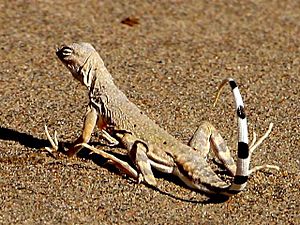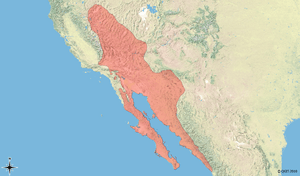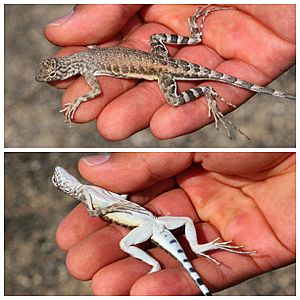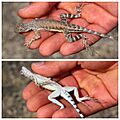Zebra-tailed lizard facts for kids
Quick facts for kids Callisaurus draconoides |
|
|---|---|
 |
|
| A zebra-tailed lizard | |
| Scientific classification | |
| Genus: |
Callisaurus
|
| Species: |
draconoides
|
 |
|
The zebra-tailed lizard (Callisaurus draconoides) is a super-fast lizard found only in the Southwestern United States and northwestern Mexico. These lizards are known for their quick movements and their cool striped tails, which look a lot like a zebra's stripes!
Contents
Where Zebra-Tailed Lizards Live
Zebra-tailed lizards love open desert areas. They prefer places with hard-packed dirt, some plants scattered around, and a few rocks. You can often find them on flat lands, in dry riverbeds called washes, and across wide plains.
What Zebra-Tailed Lizards Look Like
These lizards are usually about 2.5 to 4 inches (6.4 to 10 cm) long, not counting their tails. Their bodies are grey or sandy brown. They often have dark grey spots in pairs down their backs. These spots turn into black stripes on their tails. The underside of their tail is white with black stripes.
Boys (males) have two black spots on their sides. These spots extend to blue patches on their bellies. Girls (females) do not have these blue patches. Their black stripes on the tail might also be very light or missing.
How Zebra-Tailed Lizards Behave
Zebra-tailed lizards are active during the day and are very alert. They wake up early and stay busy, even when it's hot. When the sun is super strong, they might do a funny "dance." They stand on two legs, then switch to the other two to keep their feet cool!
When they feel scared, they run away very quickly. They curl their toes up and hold their tails high over their backs. This shows off their cool stripes! If they stop running, they wag their curled tails from side to side. This helps to confuse any animals trying to catch them. They can even run on their back legs for short distances!
These lizards are most common in areas with creosote bushes. They like to dig into soft, sandy soil to sleep at night. During the day, they often hide in the shade of bushes to stay cool. They are also known to burrow under the sand quickly if a predator is chasing them. This helps them disappear from sight.
Zebra-Tailed Lizard Reproduction
During the summer, female zebra-tailed lizards usually lay between two and eight eggs. These eggs hatch from July to November. However, a female can lay more than one group of eggs in a single season! They likely lay their eggs in loose, sandy soil. Because many animals like birds, other lizards, and mammals hunt them, they have many babies to help their species survive.
What Zebra-Tailed Lizards Eat
Zebra-tailed lizards eat a variety of things. Their favorite foods are insects like moths, ants, and bees. They also enjoy eating spiders and even other smaller lizards! Sometimes, they will eat plants, like fresh spring buds and flowers.
Where Zebra-Tailed Lizards Are Found
Zebra-tailed lizards are very common. You can find them all over the Southwestern United States. Their home ranges from the Mojave and Colorado deserts. They also live further north into the southern part of the Great Basin.
Types of Zebra-Tailed Lizards
The Callisaurus group of lizards has only one main type, which is the zebra-tailed lizard (C. draconoides). But there are nine different kinds, or subspecies, of zebra-tailed lizards! Here are some of them:
- C. d. bogerti – Bogert's zebra-tailed lizard
- C. d. brevipes – short-footed zebra-tailed lizard
- C. d. carmenensis – Carmen Island zebra-tailed lizard
- C. d. crinitus – Viscaino zebra-tailed lizard
- C. d. draconoides – common zebra-tailed lizard
- C. d. inusitanus – Sonoran zebra-tailed lizard
- C. d. myurus – Nevada zebra-tailed lizard
- C. d. rhodostictus – Mojave zebra-tailed lizard
- C. d. ventralis – eastern zebra-tailed lizard
Images for kids



